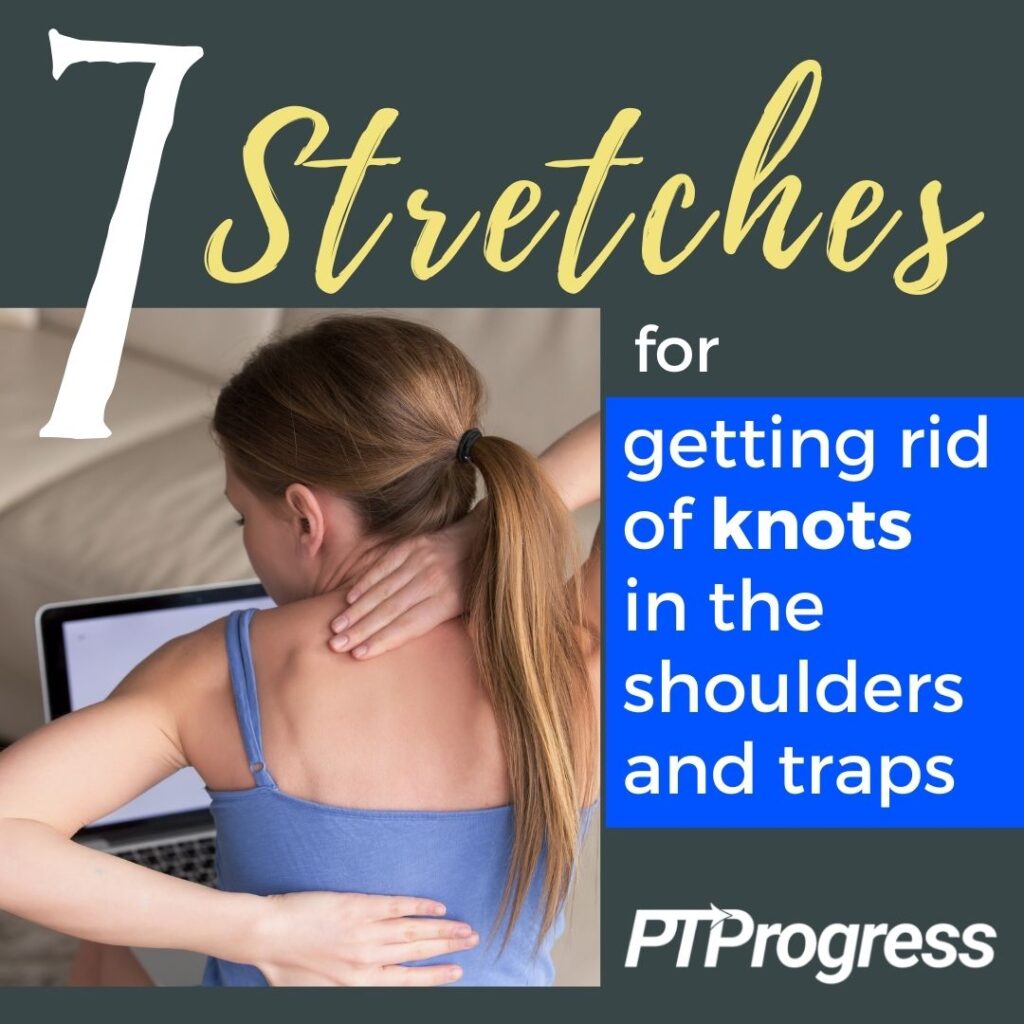
Have a minute? If you’re tired of feeling tight, check out these 7 quick stretches for getting rid of muscle knots in a pinch. Each stretch takes less than 60 seconds to perform and, with frequency, will help untie those tight knots in your shoulders and traps. As a physical therapist, I use these techniques quite often in the clinic.
60-Second Stretches for Muscle Knots
Before jumping in, remember that none of these exercises should be painful; stop what you’re doing if you start to feel pain in the affected area. As you work through each stretch, go slowly, increasing the intensity slightly and only as tolerated.
1. Scapular Retraction
You probably know that “scapular” refers to the shoulders, and the word
“retraction” denotes a “pulling back.” So scapular retraction simply means pulling your shoulders back—what we like to call a shoulder squeeze.
Whenever you round your shoulders, you shorten your pectoral and front trapezius muscles. Scapular retraction helps lengthen the front muscles while strengthening the posterior muscles you need to keep your shoulders square. Over time, this exercise will help you improve your posture and prevent future knots in your shoulders caused by poor posture.
To perform scapular retraction, simply squeeze your shoulder blades together so that they are flat on your back. Think about bringing them “back and down”—avoid shrugging your shoulders as you do this.
Each time you retract your shoulder blades, hold for 5 seconds, then relax. Repeat this movement 10 times, and within about 60 seconds you’ll have worked on a fantastic pec stretch.
2. Towel-assisted Glide
The second stretch is a towel-assisted neck glide. The towel will make it easier for you to rotate your head to the side as the muscles on the back of your neck pull towards the spine.
Place a hand towel around your neck and hold both ends. Turn your head to the left as you gently pull on the right end of the towel. Use your left hand to secure the left side of the towel as you do this.
At the end of your range, hold the head-turn position for 3–5 seconds, return to your start position, and repeat 5–10 times. If it’s tolerable, you can do this stretch on both sides.
3. Chin Tuck
One of the most important stretches you can do for tightness in the back of your neck is called a chin tuck or cervical retraction. This time, “cervical” refers to the neck, so with a chin tuck you’ll practice retracting those neck muscles that too often jut forward.
The smallest muscles of your neck are great stabilizers, but they can be tricky to pinpoint. This chin tuck exercise will help stretch the tight muscles in the back of the neck that knot up and cause tension headaches.
To perform cervical retraction, you’ll want to start with good posture, so sit or stand up tall and square your shoulders on your back. Next, slightly lower your head back and down, as if you’re giving yourself a double chin. You’ll know you’re doing this right if you feel a stretch along the base of your skull.
Hold this stretch for 3 seconds and repeat 15 to 20 times. This movement is discreet enough to do nearly anywhere, so try to perform a set of chin tucks multiple times each day.
4. Thoracic Extension at Countertop
Moving down along the spine, the space between the shoulder blades is a hot spot for muscle knots, which is why I love a thoracic extension stretch. Besides providing a few therapeutic pops in the mid-back, this exercise is great because it requires little to no equipment; it’s something you can perform at your desk at work or at home.
Find a countertop to place your elbows on as you lower your head between your arms at the countertop level. In this position, gently rock back as you lower your thoracic spine, holding for 5 to 10 seconds.
Repeat this movement 10 times and you should start to feel the pressure in your mid back release. If you’re really tight, try this movement with your arms extended on the countertop and hold for 5 to 10 seconds.
5. Wall Angel Stretch
The wall angel stretch will help lengthen the muscles that pull your shoulders forward and cause bad posture and knots.
Stand with your back against a wall and hold up your arms with your thumbs pointed towards the wall. Now slide your arms up the wall, trying to maintain contact between your hands and the wall the entire time.
If you’re especially tight, you won’t be able to go very far without lifting your arms off the wall. But once you’ve reached the end of your range, lower your arms back to the starting position and repeat this movement 10–15 times.
You can also do this stretch while lying on the ground. For more intensity, lie with your back on a foam roller. You can continue the sliding motion with your arms, or simply lie on the foam roller for 30–60 seconds. This is a great pec stretch to do daily.
6. Thoracic Extension
While you have the foam roller, check out another great way to soothe knots along the upper back. Whenever I have knots in my shoulder muscles, I like to position the foam roller perpendicular, across my mid-back.
If you’re really sore, start by crossing your arms over your chest and lean gently up and around the foam roller. This will create a slight back bend, or what we call thoracic extension.
As the movement becomes more tolerable, you can stretch into even more extension by placing your hands behind your head. Try gliding up and down the foam roller to hit more spots along your shoulders and back.
Repeat this movement 15–20 times or hold for 30–60 seconds.
7. Tennis Ball Stretch
If that doesn’t hit the spot, try this tennis ball technique. Pop a tennis ball (or lacrosse ball) inside a long sock and sling it over your shoulder. Once you’ve found the myofascial trigger points in your back and shoulders, press the ball onto your back against a wall or on the ground.
You may find it’s easier to control the tennis ball when you use the wall, as opposed to the ground. Either way, once you find a sore spot that really needs some extra attention, hold the ball there for 5–10 seconds and work around the entire area for about a minute.
Although it can feel fairly aggressive, like an angry massage therapist, the tennis ball technique is one of the most effective ways to work out those annoying, hard-to-reach knots.
7 Stretches for Muscle Knots
There you have it—some of the most effective exercises and stretches you can do to get rid of knots in your shoulders and trapezius muscle. You can perform each of these exercises in less time than it took to read this article, making it a cinch to perform several times throughout the day. Of course, one of the best ways to manage chronic pain and muscle stiffness is to remain active, stretch and perform range of motion exercises, and use an ice pack or cold therapy to relieve muscle tension.
You might also be interested in: Dry needling 101 or How to Use a Massage Gun for reducing muscle pain.

